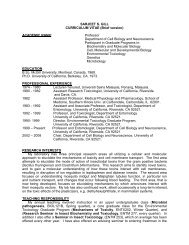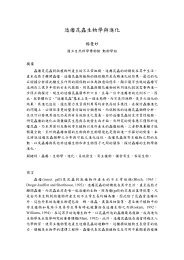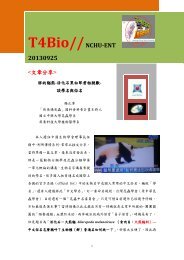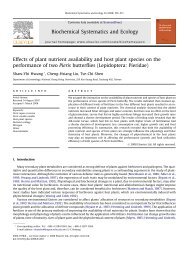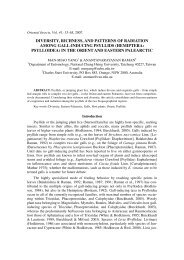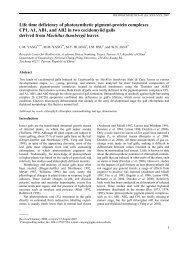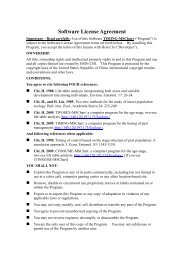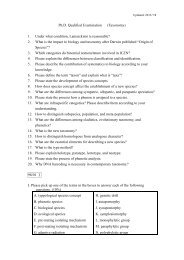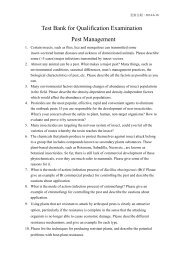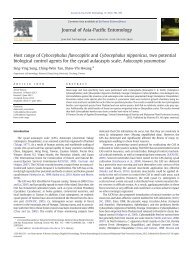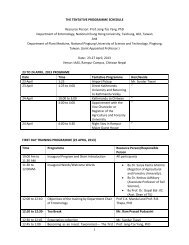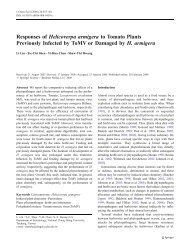Chi, H., and H. Liu. 1985. Two new methods for the study of insect ...
Chi, H., and H. Liu. 1985. Two new methods for the study of insect ...
Chi, H., and H. Liu. 1985. Two new methods for the study of insect ...
Create successful ePaper yourself
Turn your PDF publications into a flip-book with our unique Google optimized e-Paper software.
INSECT POPULATION ECOLOGY 239<br />
However, <strong>the</strong> population growth is not<br />
merely an event <strong>of</strong> numerical change with<br />
time. As a matter <strong>of</strong> fact, individuals <strong>of</strong><br />
population distributed <strong>the</strong>mselves ra<strong>the</strong>r ununi<strong>for</strong>mly<br />
in fields ( Taylor 1961). If we <strong>study</strong><br />
<strong>the</strong> population growth without considering<br />
<strong>the</strong> spatial distribution, <strong>the</strong>n we may lose<br />
ourselves in numbers <strong>and</strong> overlook some<br />
important features. On <strong>the</strong> o<strong>the</strong>r h<strong>and</strong>, if we<br />
<strong>study</strong> <strong>the</strong> spatial distribution but without<br />
considering <strong>the</strong> population growth, <strong>the</strong>n we<br />
will lose <strong>the</strong> dynamic feature <strong>of</strong> spatial<br />
distribution. For <strong>the</strong> <strong>study</strong> <strong>of</strong> <strong>the</strong> growth <strong>of</strong><br />
a “true” population, we have to set <strong>the</strong><br />
population into a space <strong>and</strong> consider <strong>the</strong><br />
changes in number <strong>and</strong> spatial distribution at<br />
<strong>the</strong> same time. Using a multidimensional<br />
matrix it is possible to do this work; <strong>the</strong><br />
population is <strong>the</strong>n taken as composition <strong>of</strong><br />
subpopulations, each subpopulation lives on<br />
its host plant <strong>and</strong> has its own age structure<br />
( or age-stage-structure ). Thus, we have <strong>the</strong><br />
age structure <strong>and</strong> spatial distribution in one<br />
model. The basic concepts have been discussed<br />
in this paper. For practical application to<br />
specific pest <strong>and</strong> host plant, o<strong>the</strong>r relevant<br />
factors must be taken into account.<br />
The multiple column matrix model is in<br />
principle developed <strong>for</strong> <strong>the</strong>oretical <strong>study</strong> on<br />
population growth with stage grouping. The<br />
multidimensional matrix model is <strong>the</strong>n <strong>for</strong><br />
<strong>the</strong> combined <strong>study</strong> <strong>of</strong> population growth <strong>and</strong><br />
dispersion. If <strong>the</strong> predator or parasite is going<br />
to be included in this model, a five dimensional<br />
matrix is necessary. The matrix SYSTEM<br />
( SPECIES,AGE,STAGE,COLUMN,ROW ) can<br />
be assigned <strong>for</strong> system simulation. Then,<br />
<strong>the</strong> experimental results such as Huffaker’s<br />
report ( 1958 ) perhaps can be studied using<br />
this method. Fur<strong>the</strong>rmore, when using <strong>the</strong>se<br />
concepts to <strong>study</strong> <strong>the</strong> intra-plant distribution<br />
on large host plant, such as trees, <strong>the</strong>n<br />
ano<strong>the</strong>r subscript HEIGHT must be used<br />
to construct <strong>the</strong> spatial structure<strong>for</strong><br />
example, POPU( AGE,STAGE,COLUMN,ROW,<br />
HEIGHT ) <strong>for</strong> <strong>the</strong> single species model or<br />
SYSTEM ( SPECIES,AGE,STAGE,COLUMN,<br />
ROW,HEIGHT ) <strong>for</strong> system simulation. Of<br />
course, it needs large memory to store <strong>the</strong><br />
matrix POPU <strong>and</strong> SYSTEM, <strong>and</strong> <strong>the</strong> simulation<br />
program can be run only on a large<br />
computer. However, it is not necessary to<br />
assign a large matrix <strong>for</strong> a field <strong>of</strong> hectares,<br />
but it must be large enough to reproduce <strong>the</strong><br />
important features <strong>of</strong> a “real” population. If<br />
<strong>the</strong> simulation can give more precise in<strong>for</strong>mation<br />
about field distribution, <strong>the</strong>n it is<br />
possible to know how many host plants bear<br />
a pest number over <strong>the</strong> predefined economic<br />
injury level, <strong>and</strong> this will be better than to<br />
use a single value, <strong>the</strong> mean density. On <strong>the</strong><br />
o<strong>the</strong>r h<strong>and</strong>, if <strong>the</strong> growth <strong>and</strong> dispersion <strong>of</strong><br />
vector population can be precisely studied,<br />
<strong>the</strong>n <strong>the</strong> research on epidemiology <strong>of</strong> plant<br />
disease transmitted by <strong>insect</strong> can be improved.<br />
The combined <strong>study</strong> <strong>of</strong> <strong>the</strong> growth <strong>and</strong><br />
dispersion is important not only <strong>for</strong> simulation<br />
works using calendar time, but also <strong>for</strong><br />
those using physiological time. We are<br />
interested in incorporating <strong>the</strong>se concepts in<br />
such simulation models. The main ongoing<br />
works in our laboratory are <strong>the</strong> fur<strong>the</strong>r<br />
development <strong>of</strong> <strong>the</strong>ories <strong>of</strong> population growth<br />
<strong>and</strong> <strong>the</strong>ir practical use in system simulation.<br />
REFERENCES<br />
ASHLEY, T. R (1976) Computer program <strong>for</strong><br />
analyzing parasitoid-host or predator-prey relationships.<br />
Fla. Entomol. 59: 27-32.<br />
CAREY, J. R. (1982) Demography <strong>and</strong> population<br />
dynamics <strong>of</strong> <strong>the</strong> Mediterranean fruit fly. Ecol.<br />
Modelling. 16: 125-150.<br />
CHI, H.(1981) Die Vermehrungsrate von Hypoaspis<br />
aculeifer Canestrini (Acarina, Laelapidae) bei<br />
Ernährung mit Onychiurus fimatus Gisin (Collembola,<br />
Onychiuridae) unter verschiedenen<br />
Temperaturen. Mitt. dtsch. Ges. allg. angew.<br />
Ent. 3:122-125.<br />
FULTON, W. C. <strong>and</strong> D. L. HAYNES (1975) Computer<br />
mapping in pest management. Environ.Entomol.<br />
4: 357-360.<br />
HAYNES, D. L. <strong>and</strong> R. L.TUMMALA (1978) Application<br />
<strong>of</strong> computer technology to pest manage<br />
ment. In pest Control Strategies (E. H. Smith<br />
<strong>and</strong> D. Pimentel, eds.). Academic Press, New<br />
York <strong>and</strong> London. pp. 181-201.



